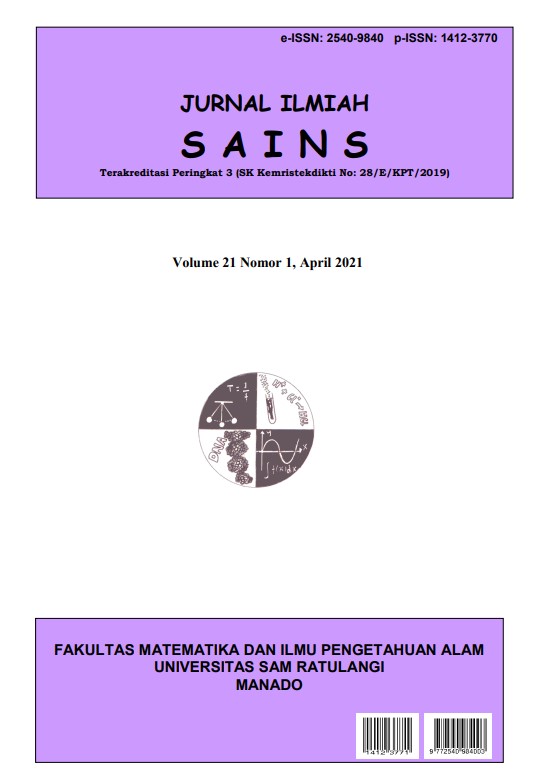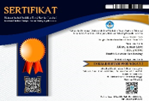Struktur dan Komposisi Vegetasi pada Suksesi di Muara Sungai Unda, Kabupaten Klungkung, Bali
DOI:
https://doi.org/10.35799/jis.21.1.2021.31744Abstract
 Letusan Gunung Agung pada tahun 1963 memberikan dampak ekologis di sekitar muara Sungai Unda, Kabupaten Klungkung, Bali. Lahar yang mengalir melalui sungai tersebut menyebabkan terjadinya suksesi primer akibat tutupan pasir dan batu. Selama 57 tahun, muara Sungai Unda tidak hanya mengalami suksesi alam, tetapi juga mengalami suksesi antropogenik melalui pemanfaatan sebagai tambang pasir, lahan pastura, dan permukiman sementara. Penelitian ini bertujuan untuk mempelajari struktur dan komposisi vegetasi pada suksesi di muara Sungai Unda. Penentuan struktur vegetasi dilakukan pada 8 stasiun penelitian dengan menggunakan metode plot dengan jumlah 24 plot pohon (20 x 20 m) dan 48 plot vegetasi lantai (1 x 1 m). Data dianalisis menggunakan parameter ekologis seperti densitas, densitas relatif, frekuensi, frekuensi relatif, dominansi, dominansi relatif, dan nilai penting, serta dilengkapi dengan indeks keragaman Shannon-Weiner (H’), indeks dominansi (C), dan indeks keseragaman (E). Hasil penelitian menunjukkan bahwa semak dan rumput merupakan bentuk hidup yang paling menentukan struktur vegetasi di Muara Sungai Unda. Beberapa spesies penyusun vegetasi tersebut merupakan tumbuhan invasif seperti yang harus dikontrol populasinya adalah Typha angustifolia, Ipomoea carnea, Chromolaena odorata, Lantana camara, dan Vachellia farnesiana. Berdasarkan indeks yang digunakan, keanekaragaman vegetasi termasuk dalam kategori tinggi, tanpa ada jenis yang mendominasi, dengan persebaran yang merata.
Kata kunci: Gunung Agung; spesies invasive; suksesi antropogenik; vegetasi suksesi
Structure and Composition of Successional Vegetation in Unda River, Klungkung Regency, Bali
ABSTRACTMount Agung eruption in 1963 caused major ecological impact around Unda River, Klungkung Regency, Bali. The volcanic mudflow that surpass the Unda River watershed initiate the primary succession in those areas. This research aimed to study the structure and composition of successional vegetation in Unda River. Twenty-four tree plots (20 x 20 m) and 48 understorey plots (1 x 1 m) derived from 8 research stations were used to determine the structure of vegetation. The data analyzed by ecological parameters, such as density, relative density, frequency, relative frequency, dominancy, relative dominancy, and importance value, then completed with Shannon-Weiner diversity index (H’), dominancy index (C), and evenness index (E). The results shown that the vegetation structure in Unda River determined by two major growth form: shrubs and grasses. Some notable invasive species that should be controlled are Typha angustifolia, Ipomoea carnea, Chromolaena odorata, Lantana camara, and Vachellia farnesiana. Based on the three indexes, the vegetation diversity was categorized as high diversity, without any species domination, and the distribution of the species are uniform
Keywords: Anthropogenic succession; invasive species; Mount Agung; successional vegetation
References
Afrianto, W.F., Hikmat, A., & Widyatmoko, D. 2016. Komunitas Floristik Dan Suksesi Vegetasi Setelah Erupsi 2010 Di Gunung Merapi Jawa Tengah. Biologi Indonesia. 12(2): 265–276.
Backer, C.A. & van den Brink, R.C.B. 1963. Flora of Java (Spermatophytes only) Volume I. Netherlands: N.V.P. Noordhoff-Groningen.
Backer, C.A. & van den Brink, R.C.B. 1965. Flora of Java (Spermatophytes only) Volume II. Netherlands: N.V.P. Noordhoff-Groningen.
Backer, C.A. & van den Brink, R.C.B 1968. Flora of Java (Spermatophytes only) Volume III. Netherlands: N.V.P. Noordhoff-Groningen.
Çakan, H., Yilmaz, K.T., Alphan, H. & Ünlükaplan, Y. 2011. The classification and assessment of vegetation for monitoring coastal sand dune succession: The case of Tuzla in Adana, Turkey. Turk J Botany, 35(6): 697–711. doi:10.3906/bot-1001-300.
Farma, A., Hikmat, A. & Soekmadi, R. 2019. Struktur dan Komposisi Vegetasi di Habitat Cemara Laut (Casuarina equisetifolia L.) pada Tiga Kawasan Konservasi di Provinsi Bengkulu. JPSL. 9(3): 596–607.
Febriana, I., Kusmana, C. & Rahmat, U.M. 2020. Komposisi Jenis Tumbuhan dan Analisis Sebaran Langkap (Arenga obtusifolia Mart.) di Taman Nasional Ujung Kulon. JPSL. 10(1): 52–65.
Githiria, J.M. & Onifade, M. 2020. The impact of mining on sustainable practices and the traditional culture of developing countries. J Environmental Studies and Science. 10(4): 394–410. doi:10.1007/s13412-020-00613-w.
Hidayat, S. 2014. Kondisi Vegetasi Di Hutan Lindung Sesaot, Kabupaten Lombok Barat, Nusa Tenggara Barat, Sebagai Informasi Dasar Pengelolaan Kawasan. J Penelitian Kehutanan Wallacea, 3(2): 97–105.
Isermann, M. 2011. Patterns in species diversity during succession of coastal dunes. J Coastal Research, 27(4): 661–671. doi:10.2112/JCOASTRES-D-09-00040.1.
Klára, Ř., Lencová, K. & Prach, K. 2018. Spontaneous establishment of woodland during succession in a variety of central European disturbed sites. Ecological Engineering, 111: 94–99.
Moradipour, L., Pourbabaei, H. & Hatami, A. 2020. Vegetation structure and floristic composition (Case study: Mala Galeh Protected area, Fars Province, Iran). JPSL, 10(3): 533–544.
Nylén, T. & Luoto, M. 2015. Primary succession, disturbance and productivity drive complex species richness patterns on land uplift beaches. J Veg Sci., 26: 267–277. doi:10.1111/jvs.12232.
Partomihardjo, T., Arifiani, D., Pratam, B.A. & Mahyuni, R. 2014. Jenis-jenis Pohon Penting di Hutan Nusa Kambangan. Jakarta: LIPI Press.
Pegman, A.P.M. & Rapson, G.L. 2005. Plant succession and dune dynamics on actively prograding dunes, Whatipu Beach, northern New Zealand. New Zealand Journal of Botany, 43(1): 223–244.
Prach, K. & Řehounková, K. 2006. Vegetation succession over broad geographical scales: Which factors determine the patterns? Preslia, 78(4): 469–480.
Prach, K., Řehounková, K., Lencová, K., JÃrová, A., Konvalinková, P., Mudrák, O., Å tudent, V., VanÄ›Äek, Z., Tichý, L., PetÅ™Ãk, P., Å milauer, P. & PyÅ¡ek, P. 2014. Vegetation succession in restoration of disturbed sites in Central Europe: The direction of succession and species richness across 19 seres. Applied Vegetation Science, 17: 193–200. doi:10.1111/avsc.12064.
Radford, I.J. 2013. Fluctuating resources, disturbance and plant strategies: Diverse mechanisms underlying plant invasions. J Arid Land., 5(3): 284–297. doi:10.1007/s40333-013-0164-0.
Suarna, I.W., Suryani, N.N. & Budiasa, K.M. 2019. Biodiversitas Tumbuhan Pakan Ternak. Prasasti, Denpasar.
Thompson, I.D., Guariguata, M.R., Okabe, K., Bahamondez, C., Nasi, R., Heymell, V. & Sabogal, C. 2013. An Operational Framework for Defining and Monitoring Forest Degradation. Ecology and Society, 18(2): 20.
Walentowski, H., Heinrichs, S., Hohnwald, S., Wiegand, A., Heinen, H., Thren, M., Gamarra O.A., Torres, Sabogal, A.B. & Zerbe, S. 2018. Vegetation succession on degraded sites in the Pomacochas Basin (Amazonas, N Peru)-Ecological options for forest restoration. Sustainability, 10(3): 1–17. doi:10.3390/su10030609.
Whitten, T., Soeriaatmadja, R.E. & Afiff, S.A. 1996. The Ecology of Java and Bali. Periplus Editions (HK) Ltd., Singapore
Windusari, Y., Susanto, R.H., Dahlan, Z. & Susetyo, W. 2011. Asosiasi Jenis Pada Komunitas Vegetasi Suksesi di Kawasan Pengendapan Tailing Tanggul Ganda di Pertambangan PTFI Papua. J Biota, 16(2): 242–251.







